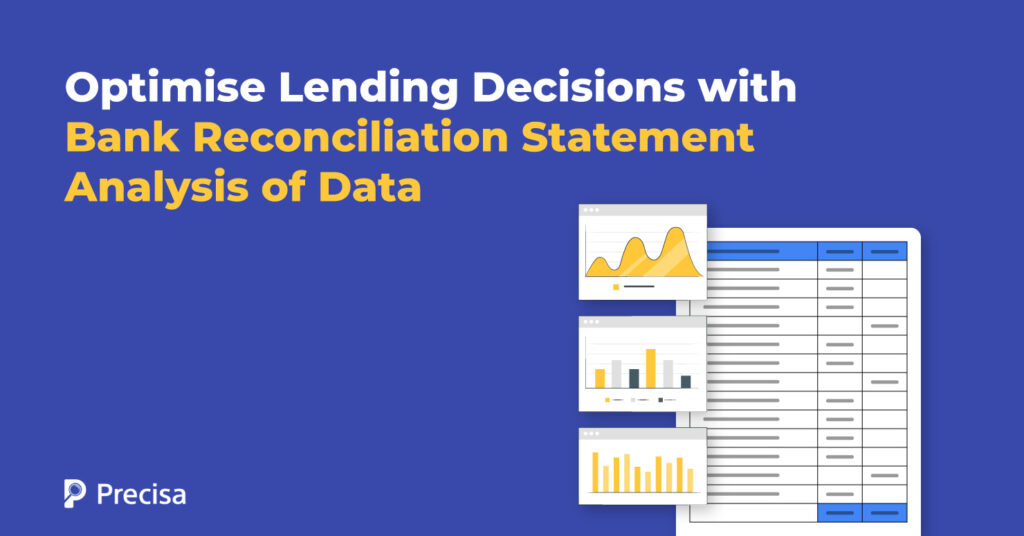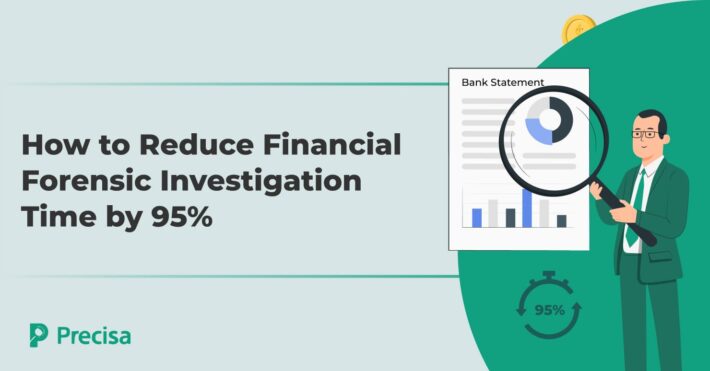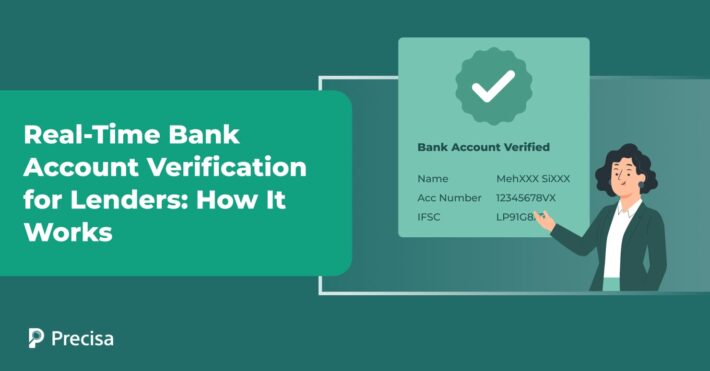Bank Reconciliation Statement Analysis of Data: Optimise Lending Decisions

Data is increasingly vital in enabling businesses to streamline their workflows, drive revenues, and become profitable in the Internet economy.
According to a McKinsey survey titled ‘The data-driven enterprise of 2025,’ adopting artificial intelligence (AI)- powered data practices is helping businesses grow revenues by at least 20% before interest and taxes.
Access to high-quality data can help lenders make accurate lending decisions as the lending industry grows. For instance, the Economic Times estimates that adopting smart technology can also enable lenders to capitalise on the opportunity to close an estimated credit gap of $530 billion among rural enterprises. Note that this segment explicitly requires loans for smaller ticket sizes.
Therefore, lenders that embrace the practice of bank reconciliation statement analysis of data can scale faster and capture higher market share.
This blog post explains what bank reconciliation is, how it works, and the core benefits of automating the process end-to-end.
What is Bank Reconciliation Statement Analysis of Data?
Every company maintains a record of its accounts. Bank reconciliation is a type of financial audit where the company’s financial records are cross-referenced with its bank statement transaction to confirm the authenticity of the records.
This process creates data transparency in many ways. Companies can:
- Detect Fraudulent Practices: These include circular transactions, revenue and profit inflation, and potential borrowers’ hidden liabilities.
- Identify Accounting Errors: Bank reconciliation enables lending teams to uncover and rectify unintentional mistakes such as data entry errors, miscalculations, or omitted transactions.
- Prevent Financial Losses: Timely reconciliations can help prevent losses from incidents such as bounced checks, bank fees, and other discrepancies that can impact a business’s bottom line.
- Safeguard Assets: Bank reconciliation also helps protect a company’s cash and other assets.
Drawbacks of Manual Bank Reconciliation
Here is a round-up of key challenges faced by lenders:
- A labour-intensive Process: Manual bank reconciliation requires a significant amount of human capital investment and a sharp eye for numbers.
- Time-Consuming: Since the process is in-depth and detailed, it consumes a significant amount of time, leading to delays in underwriting decisions.
- High Potential for Errors: There is a high potential for errors and omissions
- Low Return on Investments (ROI): Due to the high costs, delayed outcomes, and margin for error, lenders can lose potential customers. They may also fail to detect loan fraud and assess risk accurately, bringing down ROI on loan operations.
This is where bank reconciliation statement analysis of data solutions can enable businesses such as lenders to automate and bring efficiency to the entire process.
This software solution leverages technologies such as Artificial Intelligence (AL), Machine Learning (ML), cloud computing, Optical Character Recognition, and robotic automation to streamline the reconciliation workflow.
The Mechanics of Bank Statement Reconciliation Analysis of Data
Bank reconciliation statement analysis of data solutions enables lenders to automate the process completely. Data from bank statements is automatically extracted and segregated into two main categories – inflows and outflows.
The data within these categories is then further segregated into over 20 to 30 sub-categories under each section. For instance,
- Inflow Category: This includes revenue from sales, interest earned, tax refunds, and capital gains, among others.
- Outflow Category: It can include salaries paid out to employees, payments to vendors, Equated Monthly Installments (EMI) payments, and penalties, to name a few.
The entire process takes minutes, and detailed reports are generated. These reports can then be cross-referenced with the company’s accounting records to weed out any inconsistencies.
This way, the automated bank reconciliation statement analysis of data is emerging as a valuable tool in helping lenders strengthen the underwriting function.
Bank Reconciliation Statement Analysis of Data: Major Benefits

Here’s a snapshot of how automation of the bank reconciliation process enables lenders to bring data-centricity into underwriting decision-making:
Determining a Borrower’s Cash Balance
Lenders must accurately estimate a borrower’s cash balance, which is the cash value available to a borrower at any given time, especially during a crisis.
For instance, if market forces impact a business and its revenues suffer, it must be able to use the cash balance to stay operational and pay off dues such as EMIs.
Bank reconciliation statement analysis of data enables lenders to cross-check for discrepancies and ascertain the correct cash balance.
Review of Overdrafts
Business borrowers with current accounts often have access to overdrafts for emergency funding. These offer quick, easy access to smaller amounts.
However, too many overdrafts can raise red flags about a borrower’s cash flows and ability to access enough funds to repay a loan on time and in full.
The superior capabilities of bank reconciliation statement analysis of data solutions help detect overdrafts accurately, the time gap between them, and the corresponding repayment patterns.
Flagging Cases of Bounced Cheques/ Penalties
A superior bank reconciliation financial analysis software can detect cases of bounced checks, EMI payments, and penalties for defaulted payments.
For instance, if a borrower has a history of unpaid, late, or minimum credit card debt payments, the software can detect banking transactions related to these behaviours.
If a borrower issues cheques that bounce, the software isolates the corresponding penalties during the categorisation process. Such data-centricity is a valuable asset for lenders who can make data-driven decisions based on a borrower’s historic financial behaviour.
Detailed Analysis of Cash Deposits
Lenders must be able to take stock of cash deposits and, more importantly, establish their source. These details help ensure there is no fraudulent activity and that deposits are from legitimate sources such as sales, tax refunds, or capital gains.
The adoption of AI-powered bank reconciliation statement analysis of data helps account for every cash deposit and its source through the in-depth categorisation process. This allows for the explanation and verification of every cash deposit and its source.
For instance, revenue-based transactions can be cross-referenced with alternative data, such as Goods & Services Tax Returns (GSTR), to verify their authenticity.
Analysis of Withdrawals
Reviewing bank withdrawals can tell a lender a lot about a borrower’s financial habits. Bank reconciliation statement analysis of data solutions can detect unusual patterns in withdrawals and account for every withdrawal.
For example, unexplained cash withdrawals that do not reflect in the corresponding company accounts are a red flag. Such withdrawals can be used to pay existing loans or fund lavish spending habits.
Key Takeaway
Automating the bank reconciliation statement analysis of data can save lenders time and resources while bringing speed, accuracy, efficiency, and data-centricity to the underwriting process. Using technology enables lenders to reduce incidents of loan fraud and the growth of Non-Performing Assets.
Ambitious lenders can partner with a technology specialist with deep expertise in financial analysis workflows. Early investments in automating the process pave the way to function with lean teams and drive revenues through innovative, customer-centric solutions.
Precisa’s comprehensive and seamless financial data analysis solution simplifies and speeds up the process through automation. The software provides actionable insights on a customisable dashboard, thus helping companies make informed business decisions.
Request a free demo today!



